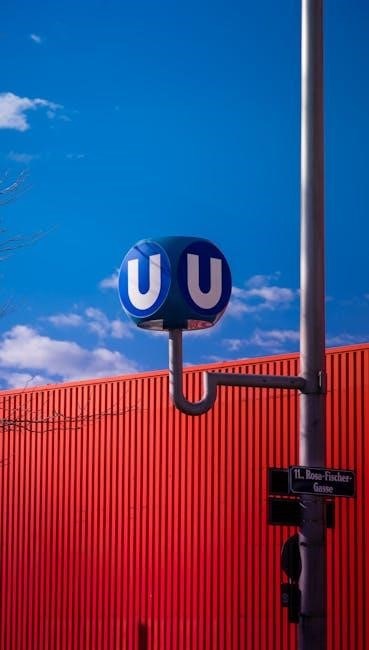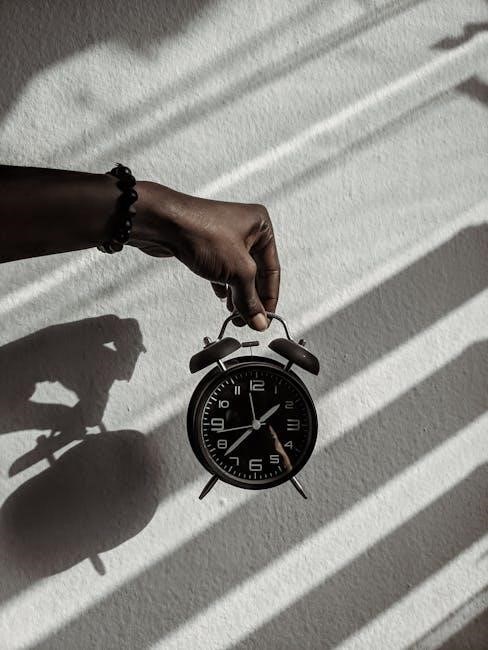The RCA RCR003RWD is a universal remote designed for easy control of multiple devices. It offers code search, direct entry, and learning functions for seamless compatibility with TVs, satellite systems, and DVD players. This remote ensures efficient operation and customization, making it a versatile tool for home entertainment systems. The user guide provides detailed instructions for setup, programming, and troubleshooting, ensuring optimal performance and ease of use.

Setting Up the Remote Control
Start by inserting batteries and turning on your device. Use code search or direct code entry to pair the remote. The learning function allows it to mimic other remotes for compatibility.
Initial Setup
Begin by inserting the batteries into the remote. Ensure the device you want to control is turned on; Press and hold the “Setup” button until the LED lights up. Release and press the device button (e.g., TV, SAT/CABLE). The LED will blink, indicating the remote is in setup mode. Use code search or direct code entry to find the correct code for your device. Once the device turns off or responds, the remote is paired. Test basic functions to confirm control. If issues arise, refer to the troubleshooting section or reset the remote. Proper setup ensures seamless operation.

Programming the Remote
Programming the RCR003RWD remote allows seamless control of multiple devices effortlessly. It offers various methods to ensure compatibility and ease of use for all your home entertainment needs.
Code Search
The RCR003RWD remote features a code search function to automatically find compatible codes for your devices. This method is ideal when you don’t have the specific codes for your TV, satellite, or DVD player. Simply turn on the device, press and hold the Code Search button, and then press the device button (e.g., TV or SAT/CABLE). The remote will emit IR signals to test codes until the device turns off or responds correctly. This process ensures quick and efficient setup without manual code entry. The code search function is a convenient option for users who prefer an automated solution.
Direct Code Entry
Direct Code Entry allows you to manually input a specific code for your device. This method is ideal if you already know the compatible code for your TV, satellite, or DVD player. To use this feature, press and hold the device button (e.g., TV or SAT/CABLE) while entering the code using the remote’s number pad. Once entered, press a function key (e.g., Power) to test if the code works. This method is quick and efficient for users who have the correct codes readily available, ensuring a seamless setup process for their devices.
Learning Function
The Learning Function on the RCR003RWD remote allows it to mimic the commands from another remote control. This feature is useful for devices without predefined codes. To use it, press and hold the device button (e.g., TV) and the desired button you want to teach simultaneously. Release, then press the button on the original remote to transmit its signal. Repeat for all necessary functions. This function ensures compatibility with devices that may not have standard codes, enabling full control customization for a seamless user experience.
Syncing with Multiple Devices
The RCR003RWD remote can sync with multiple devices, such as TVs, satellite systems, and DVD players, for unified control. After programming, it stores codes for up to three devices, allowing seamless switching between them. Syncing ensures consistent operation across all connected devices, eliminating the need for multiple remotes. This feature enhances convenience and streamlines your entertainment experience, making it easier to manage various devices with a single remote control. Proper syncing ensures reliable performance and compatibility, providing a hassle-free user experience for all your home entertainment needs.

Compatible Devices
The RCR003RWD remote is compatible with TVs, satellite/cable/streaming devices, and DVD/VCR players. It supports over 200 TV brands and various multimedia devices, ensuring wide versatility and convenience.
TVs
The RCR003RWD remote is compatible with a wide range of TV brands, offering seamless control for power, volume, and channel functions. With a comprehensive code list supporting over 200 TV manufacturers, it ensures easy setup and operation. Users can program their TV using direct code entry or the code search feature. The remote is designed to work with various TV models, providing a unified control experience. However, it does not support SIGMAC TV models. The user guide includes detailed instructions for pairing the remote with your TV, ensuring optimal performance and convenience for your home entertainment system.
Satellite/Cable/Streaming Devices
The RCR003RWD remote is designed to work seamlessly with satellite, cable, and streaming devices, offering intuitive control for channel navigation, volume adjustment, and playback functions. Users can program the remote using code search or direct code entry, ensuring compatibility with their specific device. The remote supports a wide range of brands, making it a versatile solution for managing multiple entertainment systems. The user guide provides step-by-step instructions for syncing the remote with these devices, ensuring a smooth and efficient setup process. This feature enhances the overall viewing experience, allowing users to control their entertainment systems effortlessly.
DVDs/VCRs
The RCR003RWD remote is compatible with DVDs and VCRs, offering easy control for playback, navigation, and menu access. Users can program the remote using code search or direct code entry to ensure compatibility with their specific DVD or VCR brand. The remote supports a wide range of DVD and VCR brands, making it a convenient solution for managing legacy and modern media players. The user guide provides detailed instructions for syncing the remote with these devices, ensuring a seamless setup process. This feature allows users to enjoy their media collection with enhanced control and convenience;
Using the Remote with TVs
The RCR003RWD remote is designed to work seamlessly with TVs, offering control over essential functions like power, volume, and channel navigation. Compatible with a wide range of TV brands, it simplifies entertainment by consolidating controls into one device. Setup is straightforward using code search or direct code entry, ensuring compatibility with your specific TV model. The remote also supports advanced features like learning functions, allowing it to adapt to your TV’s unique commands. Refer to the user guide for troubleshooting tips and optimal setup, ensuring a smooth and enjoyable viewing experience with your TV.

Using the Remote with Satellite/Cable Systems
The RCR003RWD remote is fully compatible with satellite and cable systems, offering intuitive control over channels, volume, and playback functions. Setup is streamlined with code search or direct code entry, ensuring compatibility with your specific system. The remote supports learning functions, allowing it to adapt to unique commands from your satellite or cable device. With its universal design, it can manage multiple devices seamlessly, reducing clutter and simplifying your entertainment experience. Refer to the user guide for detailed instructions and troubleshooting tips to optimize performance with your satellite or cable system.

Troubleshooting Common Issues
Common issues include unresponsive buttons or lost signal. Replace batteries, ensure proper alignment, and reprogram codes. Resetting the remote often resolves connectivity problems. Refer to the user guide for detailed troubleshooting steps to restore functionality and optimize performance.
Common Issues
Common issues with the RCR003RWD remote include unresponsive buttons, lost signal, or failure to sync with devices. Battery drain or incorrect code entry can also occur. If the remote stops working, check for obstructions between the remote and device. Ensure batteries are properly installed and not depleted. Verify that the correct codes are programmed for your devices. If issues persist, resetting the remote or reprogramming codes may resolve the problem. Refer to the user guide for detailed troubleshooting steps to address these common concerns effectively and restore functionality. Proper maintenance and regular checks can prevent many of these issues.
Resetting the Remote
Resetting the RCR003RWD remote restores it to factory settings, resolving issues like unresponsive buttons or syncing problems. To reset, remove the batteries, press and hold the OK and 0 buttons for 5 seconds, then release. Reinsert the batteries and test the remote. This process clears stored codes and preferences, requiring reprogramming of devices. Ensure proper battery installation and alignment during reprogramming. Resetting is a quick solution for persistent issues, allowing the remote to function optimally again. Always refer to the user guide for detailed reset instructions to avoid further complications. Regular resets can maintain the remote’s performance and reliability.

Code Lists and Compatibility
The RCR003RWD remote includes an extensive code list for compatibility with over 200 TV manufacturers, ensuring wide-ranging device support. However, it does not include codes for SIGMAC TV. The remote is designed to work seamlessly with TVs, satellite systems, and DVD players from various brands. Users can access the code list in the user manual to find specific codes for their devices. This feature ensures easy setup and optimal performance across multiple devices. The compatibility list is regularly updated, making the RCR003RWD a versatile choice for home entertainment systems. Always refer to the manual for the most accurate and up-to-date codes.
Advanced Features
The RCR003RWD offers advanced features like custom buttons and macro functions, allowing users to personalize controls and streamline commands for enhanced functionality and convenience.
Custom Buttons
The RCR003RWD remote allows users to customize buttons to their preferences, enabling quick access to frequently used functions. This feature enhances user experience by streamlining controls, making it easier to navigate and operate devices efficiently. Custom buttons can be programmed to perform specific tasks or macros, reducing the need for multiple button presses. This level of personalization ensures that the remote adapts to individual needs, providing a tailored control solution for home entertainment systems. The ability to assign custom functions to buttons makes the RCR003RWD a versatile and user-friendly remote control option.
Macro Functions
The RCR003RWD remote offers advanced macro functions, allowing users to program a sequence of commands into a single button press. This feature simplifies complex operations, such as turning on the TV, setting the volume, and switching inputs simultaneously. Macros can be customized to fit individual preferences, enhancing convenience and efficiency. By automating repetitive tasks, users can enjoy a seamless entertainment experience. The user guide provides detailed steps to set up and utilize macro functions, making it easy to create personalized command sequences for optimal control of connected devices.

Maintenance and Care
Regularly clean the RCR003RWD remote with a soft cloth and mild detergent; Avoid harsh chemicals and store it in a dry place away from direct sunlight. Handle with care to prevent damage and ensure longevity. Proper maintenance ensures optimal performance and extends the remote’s lifespan, keeping it reliable for daily use.
Cleaning the Remote
Regular cleaning ensures the RCR003RWD remote functions optimally. Use a soft, dry cloth to wipe the exterior, removing dirt and grime. For stubborn stains, dampen the cloth with water, but avoid soaking the remote. Never use harsh chemicals, abrasive cleaners, or alcohol, as they may damage the finish or harm electronic components. Gently clean between buttons with a cotton swab. Avoid exposing the remote to excessive moisture, which can interfere with its performance. Proper cleaning maintains responsiveness and prevents dust buildup, ensuring reliable operation and extending the remote’s lifespan.
Battery Care
Proper battery care is essential for the RCR003RWD remote’s performance. Use high-quality alkaline batteries for optimal power. Avoid mixing old and new batteries or different battery types. Install batteries correctly, ensuring polarity matches the remote’s diagram. Remove batteries if the remote will be unused for an extended period to prevent leakage. Store batteries in a cool, dry place. Replace batteries when the remote’s buttons become unresponsive or its range decreases. Clean battery contacts with a soft cloth to maintain good connectivity. Proper care extends battery life and ensures reliable operation of your remote control.

Downloading the User Manual
To download the RCR003RWD user manual, visit the official RCA support website or trusted platforms like ManualsLib or ManualsOnline. Search for “RCA RCR003RWD” to find the PDF manual. Ensure the source is reliable to avoid incorrect or outdated information. The manual includes detailed setup instructions, troubleshooting tips, and compatibility codes. Downloading the guide provides easy access to operating instructions, ensuring you can fully utilize the remote’s features. Save the manual for future reference to maintain optimal performance and resolve any issues quickly. This resource is essential for mastering your RCR003RWD remote control effectively.
Frequently Asked Questions (FAQs)
Common questions about the RCR003RWD include compatibility with devices, code entry issues, and syncing multiple devices. Users often ask how to reset the remote or find specific codes. The manual provides detailed solutions for these concerns. For troubleshooting, refer to the troubleshooting section. If codes for a device are missing, the learning function can help. Battery life and cleaning tips are also frequently requested. For further assistance, contact RCA support or download the updated manual from trusted sources like ManualsLib or RCA’s official website. These resources ensure smooth operation of your RCR003RWD remote control.

Safety Precautions
Ensure safe use of the RCR003RWD remote by following these guidelines. Avoid exposing the remote to liquids or extreme temperatures. Keep batteries away from children and dispose of them properly. Prevent damage by avoiding drops or heavy impacts. Clean the remote with a soft cloth and avoid harsh chemicals. Use only genuine RCA replacement parts to maintain functionality and safety. Store the remote in a dry, cool place when not in use. Follow these precautions to extend the remote’s lifespan and ensure reliable performance. Always refer to the user manual for detailed safety instructions.
Warranty and Support Information
The RCR003RWD remote control is backed by a limited warranty covering manufacturing defects for a specified period; For warranty claims, contact RCA customer support directly. Additional support is available through the official RCA website, where you can access troubleshooting guides, FAQs, and downloadable user manuals. The support team is available to assist with any issues or questions regarding the remote. Visit the RCA website for detailed warranty terms, contact information, and resources to ensure optimal use of your RCR003RWD remote control. This comprehensive support ensures a hassle-free experience for all users.
The RCR003RWD remote control is a versatile and user-friendly device designed to simplify control of multiple home entertainment systems. With its universal compatibility, advanced features like code search and learning functions, and comprehensive user guide, it offers a seamless experience for users. The remote’s ability to sync with TVs, satellite systems, and DVD players makes it an essential tool for modern households. By following the user guide, users can easily set up, program, and troubleshoot the remote, ensuring optimal performance. This guide provides all the necessary information to maximize the potential of the RCR003RWD, making it a valuable resource for any user.








































